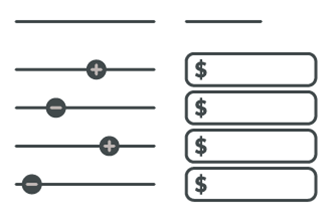Read on to get a quick overview of the main Amazon API’s (application programming interfaces) that the platform currently makes available to retrieve and use your data for Amazon marketplace management. We all know Amazon is a beast but the use of these Amazon API’s can improve the efficiency and scale of your marketplace management processes…and just maybe prevent you and your team from getting eaten alive.
From a high level, the below Amazon API data sets include Seller Central, inventory and orders management for Seller Central, advertising data for Vendor Central (Amazon Marketing Services) and Seller Central, purchase order management for Vendor Central, affiliate promotion info, and other Amazon data points you might need to manage the Amazon channel.
If you’re looking for simple and scalable access to the Amazon API’s and related data referenced in this article, please send us a note. MixShift (Formerly Dash Applications) currently provides Amazon data to agencies and brands from the Amazon Advertising API via our DATA STUDIO solution. And, we’re grinding away to do the same for Marketplace Web Services (MWS) API data, stay tuned!
Amazon API #1: Amazon Advertising API
The MWS API is your go-to API for Amazon marketplace management if you are a 3P seller of products on the Seller Central platform. This is also the API that many software developers leverage to build tools related to Amazon channel management — from listing content feeds to inventory and orders management, MWS contains a ton of useful information for 3P sellers. Because of that, MixShift is currently incorporating this Amazon data into our customers’ databases as an addition to advertising data provided via our DATA STUDIO solution.
From Amazon: Amazon MWS enables programmatic data exchange for listings, orders, payments, reports, and more. By using Amazon MWS, sellers can increase selling efficiency, reduce labor requirements, and improve response time to customers. To use Amazon MWS you must have an Amazon MWS-eligible professional selling account.
Platform: Seller Central
Who can access the MWS API: Per the message from Amazon above, you must have an Amazon Professional Selling Account on Amazon’s Seller Central platform to gain access to the MWS API. You do not necessarily have to sell products on Amazon, but you have to pay the $39.99 monthly fee to maintain a Seller account with access to the MWS API.
How to get access to the MWS API: If you follow the link above, you will see a “Register as a developer” button. You will need to have an eligible Seller Central selling account login already available to log in and complete the application process.
Amazon MWS API registration: https://developer.amazonservices.com/
What is in the MWS API: Amazon breaks the MWS API data sets out into 13 different “APIs” or endpoints within the cumulative API, all with their own url endpoints and protocol/parameter oddities. Summarily, the MWS API includes endpoints for Feeds, Finances, Fulfillment Inbound Shipment, Fulfillment Inventory, Fulfillment Outbound Shipment, Merchant Fulfillment, Orders, Products, Recommendations, Reports, Sellers, Subscriptions, and Push Notifications.
Amazon MWS API documentation: MWS API Developer documentation
Why you might need the MWS API: The MWS API data enables Seller Central merchants, or 3P sellers, to manage their Amazon presence including FBA inventory, order fulfillment, finances, order history and revenue, listing content, price monitoring, and Buy Box monitoring to name a few.
Common applications include utilizing Orders information for reporting dashboards, connecting a Seller Central product listings to a content feed for realtime listing monitoring and content updates, monitoring Buy Box and pricing to ensure resellers are not usurping sales, and managing inventory fulfillment and stock levels to ensure inventory availability in Amazon FBA centers.
Amazon API #2: Marketing Web Service (MWS)
The Amazon Advertising API provides advertising data and management capabilities for both Seller Central and Vendor Central (formerly Amazon Marketing Services) advertising accounts. Dash uses the Amazon Advertising API extensively for our DATA STUDIO and ADVERTISING STUDIO solutions. Our solutions are built specifically to provide agencies and brands with their own Amazon ad data straight from the API, along with an analytics and management platform that helps you explore and use your data right out of the box.
From Amazon: The Amazon Advertising API provides a way to automate, scale, and optimize advertising. Campaign and performance data for Sponsored Products, Sponsored Brands, and Sponsored Display are available through the API, enabling programmatic access for campaign management and reporting.
The API enables users to develop flexible solutions that meet their needs and goals, and to integrate more deeply with Amazon Advertising. The API offers most of the functionality of the advertising console while enabling programmatic management, allowing advertisers to manage ads or ad groups based on pre-defined conditions.
Platform: Seller Central & Vendor Central (Seller Central Advertising Console and Amazon Marketing Services or AMS)
Who can access the Amazon Advertising API: Only those granted access by Amazon can utilize the Amazon Advertising API.
How to get access to the Amazon Advertising API: Amazon Advertising API access is gated and you must apply for access per the link below.
Amazon Advertising API registration form: https://advertising.amazon.com/about-api
What’s in the Amazon Advertising API: Your Amazon advertising data and related management functionality are included via the Amazon Advertising API. This encompasses information for advertising Profiles, Portfolios, Sponsored Brands, Sponsored Products, and Sponsored Display ads. With access to the API, you are able to retrieve data for and modify elements of, campaigns, ad groups, product ads, reports, targeting, and negative targeting dimensions.
Amazon Advertising API documentation: https://advertising.amazon.com/API/docs/en-us/get-started/overview
Why you might need the Amazon Advertising API: Typically, Sellers and Vendors, along with the agencies that may be managing the Amazon channel, use the available data for ad reporting, management, and analytics purposes as they look to scale Amazon advertising operations. Stable access to this data on an ongoing basis is an important element of scaling operations for both brands and agencies alike.
Amazon API #3: Vendor Central EDI
As of June 2020, Amazon finally beta released the much talked about Vendor Central Selling Partners API. Excited about the prospect of getting more VC reporting data out of Amazon? So were we but were sorely disappointed when we finally got a glimpse at the API documentation for this new API. The API is basically just the EDI (described below) updated for modern-day applications with a RESTful structure. You won’t find any performance reporting such as Amazon orders, sessions, pageviews, Buy Box, etc.; but rather can manage purchase order procurement and fulfillment. If you’re curious about what is included in the API, check out Sam Gonzales’s article here: AMZ Group on Selling Partners API
Although not technically an API, the EDI (Electronic Data Interchange) found in Amazon’s Vendor Central is the main option, aside from unstable scraping technologies, for Vendors, or 1P brands, to pull and push data for Vendor Central management. Dash does not currently work with the EDI connection due to its limited data set and accessibility but we will explore further when the Direct Fulfillment API is released this year per the below from Amazon.
From Amazon: Electronic integration with Amazon enables you to improve and maintain your performance and grow your Direct Fulfillment business with us. However, we recommend waiting until the launch of API self-service setup via Vendor Central (similar to EDI self-service setup) coming in summer 2020, which will make integration easier.
Platform: Vendor Central
Who can access the Vendor Central EDI: Only those with a valid Amazon Vendor Central account can access the EDI and its related capabilities.
How to get access to the Vendor Central EDI: If you have a Vendor Central account, you can access the EDI endpoints directly from your account per the screenshot shown above.
What’s in the Vendor Central EDI: The Selling Partners API will be organized in three different sections of Inventory Management, Order Fulfillment, Payment Management, and Transaction Management. For now, the self serve section of the EDI includes options to connect to Global Settings, Purchase Orders, Advance Shipment Notifications, Invoices, Cost and Inventory feeds, Sales reports, Purchase order changes, and Purchase order change acknowledgements.
Why you might need the Vendor Central EDI: Integrating your processes with EDI information enables a 1P Amazon vendor to manage Vendor Central PO management and fulfillment, along with general Vendor Central performance monitoring. A common application of EDI information is incorporating PO information into an ERP system so the Vendor can process orders within the ERP instead of through the Vendor Central portal. Other applications include fulfilling orders to Amazon, synchronizing inventory, submitting invoices to Amazon, and managing API transactions.
Amazon API #4: Product Advertising for Amazon Associates (Affiliates
One of the more obscure Amazon API’s, the Product Advertising API was originally designed for affiliates of Amazon who are part of the Amazon Associates program. Basically, the intent of the API is to allow affiliates to pull Amazon product listing details to display and promote products on their own sites. However, because software developers used the Product Advertising API to build Amazon listing and rank tracking software, Amazon has severely restricted access to, and usage of, this API.
From Amazon: As a developer, you can build Product Advertising API applications that leverage this robust, scalable, and reliable technology. You get access to a lot of the data used by Amazon including the items for sale, customer reviews, seller reviews, as well as most of the functionality you see on Amazon.com, such as finding items, displaying customer reviews, and product promotions. Product Advertising API operations open the doors to Amazon’s databases so that you can take advantage of Amazon’s sophisticated e-commerce data and functionality. Build your own web store to sell Amazon items or your own items.
Platform: Seller Central & Vendor Central (Seller Central Advertising Console and Amazon Marketing Services or AMS)
Who can access the Product Advertising API: Amazon Associates who have been accepted into the program.
How to get access to the Product Advertising API: First, apply to be an Amazon Associate. Once accepted, you can apply for access to the Product Advertising API via the Associates console.
Amazon Associates sign up: https://affiliate-program.amazon.com/
What’s in the Product Advertising API: The Product Advertising API allows affiliates to find Amazon listing items, find out more about specific items, create a shopping cart, and navigate the Amazon browse tree nodes.
Product Advertising API documentation: https://docs.aws.amazon.com/AWSECommerceService/latest/DG/Welcome.html
Why you might need the Product Advertising API: If you’re looking to promote Amazon-listed products on your own website, this is the API for you. A common application of the Product Advertising API data is to display specific Amazon product listing content on your high-traffic site to generate additional website revenue via affiliate payouts from Amazon.
Summary
There are a number of different Amazon API’s available that can make the marketplace just a little bit easier to manage, and to create scale in your team’s processes so the beast doesn’t end up eating you.
As always, please feel free to reach out to the dash APPLICATIONS team with any questions, thank you!





